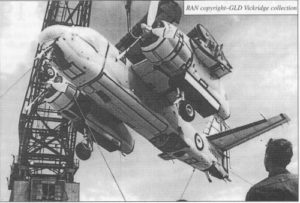- Author
- Vickridge, G.L.W., Lieutenant, RANR
- Subjects
- Ship design and development, Naval technology
- Tags
-
- RAN Ships
- 816 Squadron, HMAS Albatross, HMAS Hobart I, HMAS Melbourne II, 851 Squadron
- Publication
- September 2000 edition of the Naval Historical Review (all rights reserved)

In 1967, the RAN acquired its first American aircraft. Seen here is one of fourteen Grumman S-2E Trackers being offloaded from the aircraft carrier HMAS Melbourne at Garden Island Dockyard in Sydney after the delivery voyage from NAS North Island at Coronado, California in December of that year. The aircraft were towed to the Hawker de Havilland facility at Bankstown for ‘de-cocooning’ and readiness for the short flight to NAS Nowra. On 10 January 1968, 816 Squadron re-commissioned with six Trackers with 851 Squadron commissioning later that year with six of the remaining aircraft, the other two being kept in reserve or undergoing major overhaul. Although the largest operational aircraft ever operated by the RAN, nonetheless, its compactness is clearly visible.
In service with the Australian, United States, Canadian, Japanese, Brazilian, Dutch and Italian Navies, the Tracker was the foremost carrier-borne anti-submarine warfare aircraft between the 1950s and the 1970s. The RAN was the only service to operate the aircraft with one pilot, the second pilot replaced by an observer as the function was primarily tactical navigation which was more suited to the Australian ‘lookers’ than the (generally) inexperienced pilots who were used in other services. The front seat observer or tacco (tactical coordinator) operated the computerised tactical navigation equipment, communications equipment and the 70 million candlepower searchlight as well as assisting the pilot with the weapons panel and the general running of the aircraft. In the rear crew compartment, the radar, MAD equipment, ECM and ‘sniffer’ gear were operated by non-commissioned aircrew while the underwater detection equipment, Julie and Jezebel, was operated by a junior observer. These systems used active and passive sonobuoys. 32 of which were carried at the rear of the engine nacelles. The observers and aircrew men were cross-trained in the use of all ‘back seat’ equipment.
An all-weather aircraft with the appropriate navigational aids, the Tracker was operated as low as 100 feet above the sea in daylight but no lower than 300 feet at night. Typical sorties were 5 to 6 hours in length with the crew strapped in for the duration; in winter, to add to their discomfort, they wore rubber immersion suits. Each of the four crew sat on a one-man inflatable dinghy with a parachute as the back rest. Food was always cold and came in a box. During the day, an upturned Aldis lamp was sometimes used to heat pies but for obvious reasons, it could not be used in the cockpit at night. Relief was exceedingly basic as the aircrew in the front of the aircraft used a tube which was stowed under their seat. The back-seat aircrew had to request permission to unstrap and use a tube in the electronics compartment.




